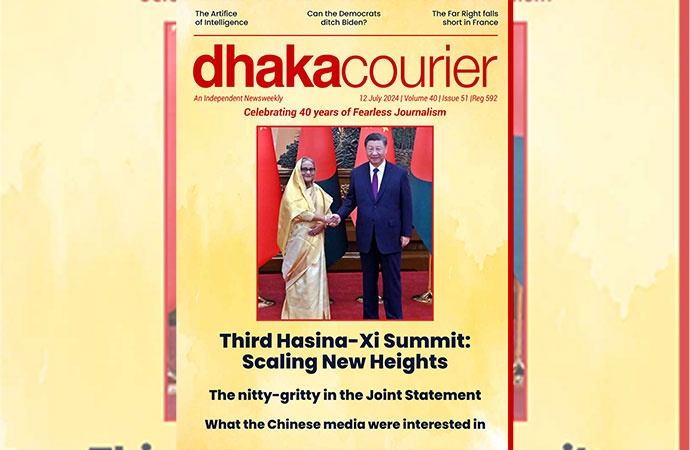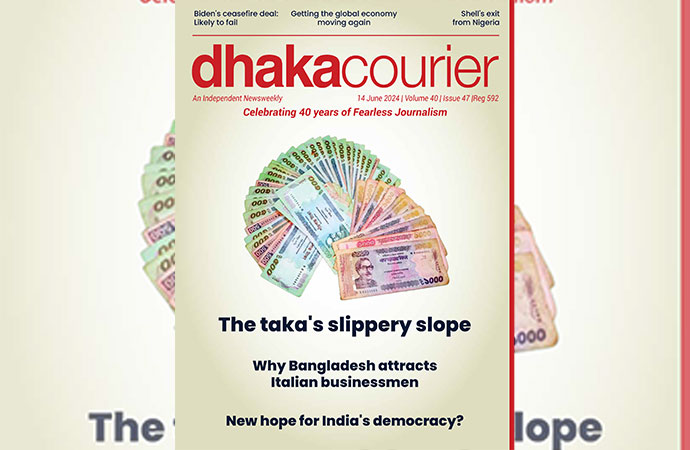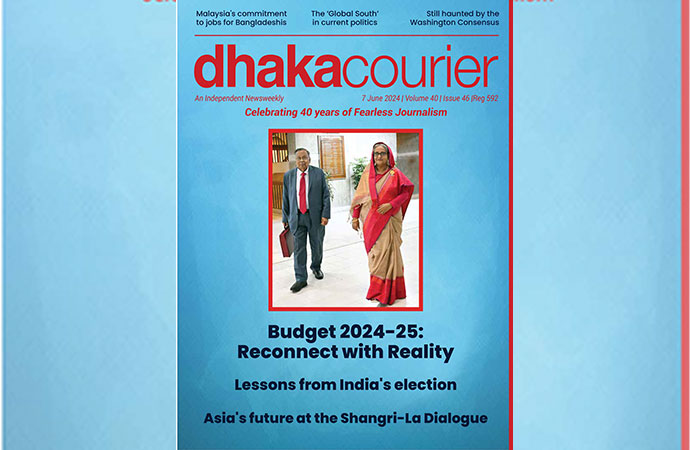Featured 2





To identify the personal hallmark of artist Tajuddin Ahmed who has been living in Toronto since 2008, one is required to look at his current practice in the context of the abstract movement in the country which saw its start in the early 1960s. What distinguishes him from the first generation abstractionists is his use of layers. Behind the tactility of his works lies the process of applying layers of paint used to define forms and shapes - his aesthetic objects. As he continues to apply additional layers of drawings onto the picture plane until he feels that he has achieved his goal, his works often seem vaguely related to the urban reality. The act of arranging colours and space lends his works a vigour that easily attracts the art enthusiasts' attention.
Tajuddin's recent works' refined take on the same visual logic he has been applying since the 1990s. Yet the recent works are different to some extent from his earlier forays. At present, his canvases are populated with tiny object-like forms of different types. Even myths, symbolic patterns and suggestive forms appear on his otherwise abstract painted spaces primed with rough textures.
Tajuddin's paintings are also a demonstration of his disengagement with the heavy impasto of his earlier paintings. In most of the works application of texture has mellowed affecting the surface which now looks more soothing than ever before. The sentimental responses to the location he grew up in - the city of Dhaka, now defaced amidst unplanned growth, somehow made way for some universal matrices involving compositional balance and exuberance of colours.
In contrast to his main oeuvre there are a couple works that demonstrate his inclination towards the folkloric. The use of human figures along with floral motifs as well as suggestions of plants, birds, shrubs and animals such as elephant, horse make his journey to an exceptional site for experiencing Tajuddin's works. A whimsical vision appears in many a work, albeit some even look intentionally neat and tranquil as the works focus on colours and their layered application. Colours in some works have appeared rather flat - without tint or shade.
I have known Tajuddin for more than twenty years as an abstract expressionist, skilled and acute observer. I am very deeply impressed by the range of his works, his compositions and the way he presents his inner thoughts and his surrounding ambiances. He is also very courageous and has a strong control over canvas and large-sized papers. He never feels afraid to work with large canvases. To him, a large canvas gives the opportunity to express himself properly. Tajuddin has worked with different mediums and his mode of expression is pure abstract expressionism. I think Tajuddin is a very outstanding painter because of his sincerity, in-depth observation of topics and above all his unpretentious approaches.
Tajuddin is one of the foremost painters of the late-1970s who began his formal career as a semi-abstract painter and his themes include urban landscape, mysterious nature, longing and expressions of emotions. In the late '70s, his works were engrossed with a powerful engagement with figure, object and space, and with bold and sweeping brushstrokes. He played with texture and illusion for the surface effects. Space was created on the canvas although some of the colours appeared flat in the works of that period. The tonal-plus-linear approach gives his works a different quality and distinct look from the onset.
During the late 1980s, Tajuddin appeared to us as a true naturist painter. At that time, he completely took inspiration from nature. That inspiration is evident in his paintings that delineate the splendour of both rural and urban landscape. At that time, his mode of expression was semi-realistic with a touch of impressionism and post-impressionism. His keen aptitude is to paint the philosophical aspect of nature, volume and colour and to create poetic compositions. He feels rhythm is the main root of all creations. Nature has its own rhythm and his main focus is to unfold the pulses of nature.
With the passage of time, Tajuddin has refined himself. He transformed himself as a semi-abstract painter after the 1990s and set off to interpret metropolitan community rigorously through thematic treatment. He intimately observed the city's unplanned urbanisation, ruined richness of heritage, transports, changing socio-political and economic conditions. For deeper inspiration and bringing variation in his theme centric works, the artist fervently painted Old Dhaka with its vibrant activities, downtrodden people in their daily chores, rickshaws and their hapless but dauntless drivers, light posts, narrow alleys, condensed habitations, wrecked buildings, cluttered wires pondering across roads etc. He also depicted people in masses busy with their different approaches and aided by sufferings, torments, bliss and ecstasies. He occupied himself mostly with oil medium and the medium gave him a true sense of persistence. As the paint is a beautiful medium, it can attain buttery glosses, thin luminescent glazes, and rich colours like none other.
Tajuddin's paintings from this period (afterwards he also worked on the same topics) also highlight wheels, prostitution and familiar features of the city. Gradually figures died out in his works and various kinds of forms, symbols, textures, oval, triangular and rectangular shapes and lines took over the canvas. Geometric structures, architectural and structural views give a new perspective to his works. Adjoining columns, slabs, walls, broken pillars, elephant forms compass, broken doors, windows and others are also apparent in his works. His canvas is truly representative of our modern urban milieu.
After the late 1990s, Tajuddin completed his artistic journey to become a pure abstract expressionist painter. His paintings delved deep into pure forms, compositions and hues which have been used according to the space. Sometimes he played with neat forms and compositions and time and again, occupied himself with healthy curved horizontal and vertical lines, straight lines, elliptical, non- elliptical shapes, cubic forms and rigid structure. He played with space and sometimes the space played a vital role for many of his paintings. Occasionally forms engrossed either middle or lower parts of the canvas. Sometimes it seemed he was more conscious about space and forms. The application of forms gives a cerebral and contemplative look to his works. His works are very expressive due to the effective use of space in his paintings during this period. During the time, many of his paintings feature complex compositions, textural strength and thickness of colours. A number of his paintings look neat and tranquil as the works focus on colours and their various layers. The colours are azure, crimson, red, black, white, yellow, cobalt blue, yellow ochre, purple ochre, burnt sienna, umber and emerald green. The painter has played with texture and illusion for surface effects, as his surfaces look more impressive and appealing.
A couple of works by Tajuddin demonstrate his inclination towards folk art. He sometimes uses figures of humans along with flowers, tiny plants, birds, elephants, horses, tiny bushes and animals. Each work depicts a complete story that hides our identity. In some paintings, flowers, animals like horses and elephants have been presented. The paintings are primitive in nature and at the same time modern in their execution. The treatment of lines is simple but untrained giving nature an authentic illustrative expression via his paintings.
Over the years Tajuddin has kept pace with technical and methodical advancements and has used these to further develop himself as a creative interpreter of nature and insight of human being. He has been symbolically recording every aspect of life in his surroundings, thereby validating his keen observation skills for studying socio-economic, political and cultural lives in all their manifestations.
The writer is an art critic and cultural curator.

























Leave a Comment
Recent Posts
How China's reform benefit the ...
"It's very clear that China has entered a new era under Presi ...
How do we heal?
After the unprecedented violence of the past two weeks, the most impor ...
The High Court fixed July 25 for delivering verdicts
Biden’s legacy: Far-reaching accomplishments that di ..
US President Joe Biden dropped out of the 2024 race
“A kiss over bribe”: Nachiketa’s social message to D ..